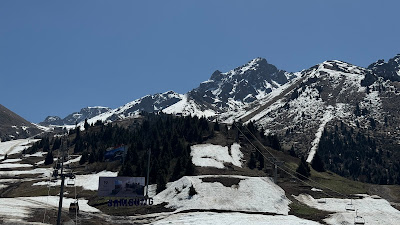Monday, May 5th.
Today, we have a full-day tour of Almaty, a relatively young city compared to its Central Asian counterparts. Founded in 1854 by Russian settlers, Almaty initially existed as a small fort. Its name has evolved through various stages, from Zailisky to Verny, before finally settling on Alma-Ata ("Father of Apples") in 1929. In 1993, the city's name was changed to Almaty. This was originally the capital city of the country but with independence in 1987 the capital was moved further the interior of the country to the newly created city of Astana. However, this is the cultural and economic centre of the country. In 1986 the Soviet supported leader of Kazakhstan renamed the capitial city after himself. There was a protest instigated by students and citizens who were upset that he was not a Kazak, and as a result three years later the name of the city reverted to Astana. This was the fuse that ignited the political chain reaction that ulitmately led to the dissolution of the USSR and the independence of the Stans and ulitimately Kazakhstan oin December 16, 1991. Almaty was also where the meeting of all the Soviet states determined that the USSR was dead and then the Stans all became independent. In the morning we had a half hour drive to the local skiing region in the Tyanshan mountain range. We took three separate gondola rides up to the top at 3200 metres to the Shymbulak Mountain Resort, where there was still snow but no skiing as the season is over. The views were spectacular. On the way we ‘flew’ over the renowned Medeo high-altitude speed-skating complex where numerous world speed skating records have been set because of the altitude. We also saw the Medeo Dam, a vital infrastructure project that plays a crucial role in the region's water supply and protects the city below from landslides, avalanches and flooding. From the top we could see the city in the haze of either dust or pollution, we’re not really sure which. Returning to the city center, we delve into its cultural heritage at the Central State Museum.The museum's ethnic section is a highlight, featuring a dedicated hall that showcases the diverse cultures and traditions of Kazakhstan's nomadic tribes. This section provides valuable insights into the region's rich heritage and the nomadic lifestyle that has shaped its identity. To experience the city's modern infrastructure, we made a short detour to explore a couple of Almaty's metro stations, which were completed in 2011. The metro system features two lines, each adorned with unique and artistic designs that reflect the city's culture and history. Then we revisited the beautiful Russian Orthodox Zhenkov's Cathedral. It is entirely made from wood including the nails. It was great to see it in the sunshine and to have a chance to enter. Inside there was a service underway so we had to be quiet and respectful while admiring the beauty of the artwork and gold trim of the baptistery and the paintings on the walls. It is another stunning structure built by man to an imaginary deity.














Almaty looks like a little more unique place so far on your travels. As usual, I'm always impressed with shots of mountainous areas and it was a bit of a surprise to see you and John walking around surrounded by snow. Nice theological flurry to end your post, by the way.
ReplyDelete